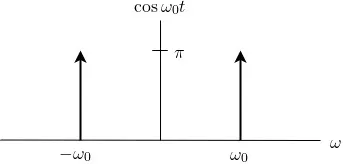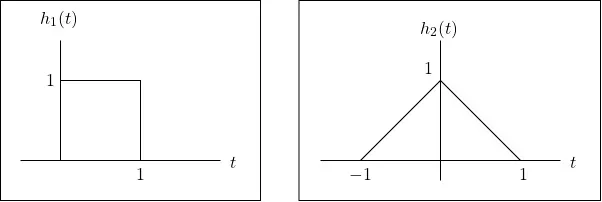
[Image1]
Introduction
Hey it's a me again @drifter1!
Today we continue with my mathematics series about Signals and Systems in order to cover Exercises on Sampling and Interpolation.
So, without further ado, let's dive straight into it!
Sampling Example [Based on 16.2 from Ref1]
Consider the system shown below:

Sketch the Fourier Transform of the output,  , in the range
, in the range  for various values of
for various values of  , in order to identify at least one value pair with identical
, in order to identify at least one value pair with identical  (or
(or  ).
).
Solution
The Fourier Transform of the sampling function  , which is
, which is  , is given by:
, is given by:

Graphically, there are basically impulses of  every
every  , as shown below:
, as shown below:

Now for the input signal,  .
Its spectrum is a sum of two impulses,
.
Its spectrum is a sum of two impulses,  , and so the plot is as follows:
, and so the plot is as follows:

Based on the convolution theorem, its straighforward to plot  , because its simply:
, because its simply:

This basically means that the graph of  is repeated at the center of each impulse of
is repeated at the center of each impulse of  , giving one inpulse to the left, and one impulse to the right, with a distance that depends on the value of
, giving one inpulse to the left, and one impulse to the right, with a distance that depends on the value of  .
.
As such, in the case of  , the output is:
, the output is:

For  :
:

For  :
:

For  adjacent impulse pairs "fuse" together leading to double the magnitude:
adjacent impulse pairs "fuse" together leading to double the magnitude:

Lastly, for  we get the same output as with
we get the same output as with  , because the impulse pairs "overlap" each other, as shown below with easy-to-see colour coding:
, because the impulse pairs "overlap" each other, as shown below with easy-to-see colour coding:

The same also occurs in the case of the value pair  , and also for
, and also for  .
.
Interpolation Example [Based on 17.2 from Ref1]
Consider the signal  , which we want to interpolate using the following generic LTI system:
, which we want to interpolate using the following generic LTI system:

Let's sketch out the output  for the following choices of
for the following choices of  :
:

Solution
The signal  can be visualized as follows:
can be visualized as follows:

For both choices of  , the output is simply the superposition of the two signals.
Therefore, the output can be sketched quite easily, as seen below:
, the output is simply the superposition of the two signals.
Therefore, the output can be sketched quite easily, as seen below:

RESOURCES:
References
Images
Mathematical equations used in this article were made using quicklatex.
Block diagrams and other visualizations were made using draw.io and GeoGebra
Previous articles of the series
Basics
- Introduction → Signals, Systems
- Signal Basics → Signal Categorization, Basic Signal Types
- Signal Operations with Examples → Amplitude and Time Operations, Examples
- System Classification with Examples → System Classifications and Properties, Examples
- Sinusoidal and Complex Exponential Signals → Sinusoidal and Exponential Signals in Continuous and Discrete Time
LTI Systems and Convolution
- LTI System Response and Convolution → Linear System Interconnection (Cascade, Parallel, Feedback), Delayed Impulses, Convolution Sum and Integral
- LTI Convolution Properties → Commutative, Associative and Distributive Properties of LTI Convolution
- System Representation in Discrete-Time using Difference Equations → Linear Constant-Coefficient Difference Equations, Block Diagram Representation (Direct Form I and II)
- System Representation in Continuous-Time using Differential Equations → Linear Constant-Coefficient Differential Equations, Block Diagram Representation (Direct Form I and II)
- Exercises on LTI System Properties → Superposition, Impulse Response and System Classification Examples
- Exercise on Convolution → Discrete-Time Convolution Example with the help of visualizations
- Exercises on System Representation using Difference Equations → Simple Block Diagram to LCCDE Example, Direct Form I, II and LCCDE Example
- Exercises on System Representation using Differential Equations → Equation to Block Diagram Example, Direct Form I to Equation Example
Fourier Series and Transform
- Continuous-Time Periodic Signals & Fourier Series → Input Decomposition, Fourier Series, Analysis and Synthesis
- Continuous-Time Aperiodic Signals & Fourier Transform → Aperiodic Signals, Envelope Representation, Fourier and Inverse Fourier Transforms, Fourier Transform for Periodic Signals
- Continuous-Time Fourier Transform Properties → Linearity, Time-Shifting (Translation), Conjugate Symmetry, Time and Frequency Scaling, Duality, Differentiation and Integration, Parseval's Relation, Convolution and Multiplication Properties
- Discrete-Time Fourier Series & Transform → Getting into Discrete-Time, Fourier Series and Transform, Synthesis and Analysis Equations
- Discrete-Time Fourier Transform Properties → Differences with Continuous-Time, Periodicity, Linearity, Time and Frequency Shifting, Conjugate Summetry, Differencing and Accumulation, Time Reversal and Expansion, Differentation in Frequency, Convolution and Multiplication, Dualities
- Exercises on Continuous-Time Fourier Series → Fourier Series Coefficients Calculation from Signal Equation, Signal Graph
- Exercises on Continuous-Time Fourier Transform → Fourier Transform from Signal Graph and Equation, Output of LTI System
- Exercises on Discrete-Time Fourier Series and Transform → Fourier Series Coefficient, Fourier Transform Calculation and LTI System Output
Filtering, Sampling, Modulation, Interpolation
- Filtering → Convolution Property, Ideal Filters, Series R-C Circuit and Moving Average Filter Approximations
- Continuous-Time Modulation → Getting into Modulation, AM and FM, Demodulation
- Discrete-Time Modulation → Applications, Carriers, Modulation/Demodulation, Time-Division Multiplexing
- Sampling → Sampling Theorem, Sampling, Reconstruction and Aliasing
- Interpolation → Reconstruction Procedure, Interpolation (Band-limited, Zero-order hold, First-order hold)
- Processing Continuous-Time Signals as Discrete-Time Signals → C/D and D/C Conversion, Discrete-Time Processing
- Discrete-Time Sampling → Discrete-Time (or Frequency Domain) Sampling, Downsampling / Decimation, Upsampling
- Exercises on Filtering → Filter Properties, Type and Output
- Exercises on Modulation → CT and DT Modulation Examples
Final words | Next up
And this is actually it for today's post!
From next time on we will start getting into other kinds of Transforms, which will also lead to the end of this amazing series...
See Ya!

Keep on drifting!
